
Am Fam Physician. 2015;91(1):46-52
A more recent article on eating disorders in primary care is available.
Patient information: See related handout on eating disorders, written by the authors of this article.
Eating disorders are life-threatening conditions that are challenging to address; however, the primary care setting provides an important opportunity for critical medical and psychosocial intervention. The recently published Diagnostic and Statistical Manual of Mental Disorders, 5th ed., includes updated diagnostic criteria for anorexia nervosa (e.g., elimination of amenorrhea as a diagnostic criterion) and for bulimia nervosa (e.g., criterion for frequency of binge episodes decreased to an average of once per week). In addition to the role of environmental triggers and societal expectations of body size and shape, research has suggested that genes and discrete biochemical signals contribute to the development of eating disorders. Anorexia nervosa and bulimia nervosa occur most often in adolescent females and are often accompanied by depression and other comorbid psychiatric disorders. For low-weight patients with anorexia nervosa, virtually all physiologic systems are affected, ranging from hypotension and osteopenia to life-threatening arrhythmias, often requiring emergent assessment and hospitalization for metabolic stabilization. In patients with frequent purging or laxative abuse, the presence of electrolyte abnormalities requires prompt intervention. Family-based treatment is helpful for adolescents with anorexia nervosa, whereas short-term psychotherapy, such as cognitive behavior therapy, is effective for most patients with bulimia nervosa. The use of psychotropic medications is limited for anorexia nervosa, whereas treatment studies have shown a benefit of antidepressant medications for patients with bulimia nervosa. Treatment is most effective when it includes a multidisciplinary, team-based approach.
Eating disorders have traditionally been classified into two well-established categories. They are anorexia nervosa and bulimia nervosa.1 Additionally, many patients have been classified as having the residual category of eating disorder not otherwise specified.2 Revisions in the recently published Diagnostic and Statistical Manual of Mental Disorders, 5th ed., (DSM-5) may facilitate more specific eating disorder diagnoses.3,4 The DSM-5 includes a diagnostic category for binge-eating disorder, which is characterized by a loss of control and the feelings of guilt, shame, and embarrassment. The disorder is not associated with self-induced vomiting or other compensatory behaviors; hence, patients are typically overweight or obese. Other feeding and eating disorders in the DSM-5 include pica, rumination disorder, and avoidant/restrictive food intake disorder.3 This article focuses on anorexia nervosa and bulimia nervosa.
| Clinical recommendation | Evidence rating | References |
|---|---|---|
| Initial evaluation of patients with eating disorders requires assessing medical stability and whether hospitalization is required. | C | 3, 11, 12, 35, 37, 38 |
| In patients with eating disorders, assess for psychiatric comorbidities, including depression and suicide risk, anxiety disorders, and substance use disorders. | C | 3, 11, 12, 38–40 |
| An interdisciplinary team approach is needed for the treatment of eating disorders, and often includes a family physician, a psychotherapist or psychiatrist, a dietitian, an eating disorder specialist, and school personnel. | C | 11, 12, 21–26, 35, 36 |
| A minimum weight restoration target for patients with anorexia nervosa is 90% of the average weight expected for the patient's age, height, and sex. | C | 12, 22 |
| Family-based treatment (the Maudsley method) is effective for treating anorexia nervosa in adolescents. | B | 23, 24 |
| Most patients with bulimia nervosa benefit from psychotherapy such as cognitive behavior therapy and/or treatment with a selective serotonin reuptake inhibitor. | B | 11, 12, 26, 27, 35–37 |
| Antipsychotic medications are generally not effective in the treatment of eating disorders. | B | 11, 32–35 |
Definition
The DSM-5 diagnostic criteria for anorexia nervosa (Table 13 ) are similar to the previous DSM-IV criteria with respect to behavioral and psychological characteristics involving restriction of food intake resulting in low body weight, intense fear of gaining weight or becoming fat, and disturbance of body image.1,3 Notably, the DSM-5 criteria do not refer to a specific degree of weight loss required for the diagnosis, but instead provide guidelines for specifying the severity of weight loss. As in the DSM-IV, the new criteria specify two diagnostic types of anorexia nervosa (restricting type and binge eating/purging type). In a significant revision to previous criteria, diagnosis of anorexia nervosa no longer requires the presence of amenorrhea.
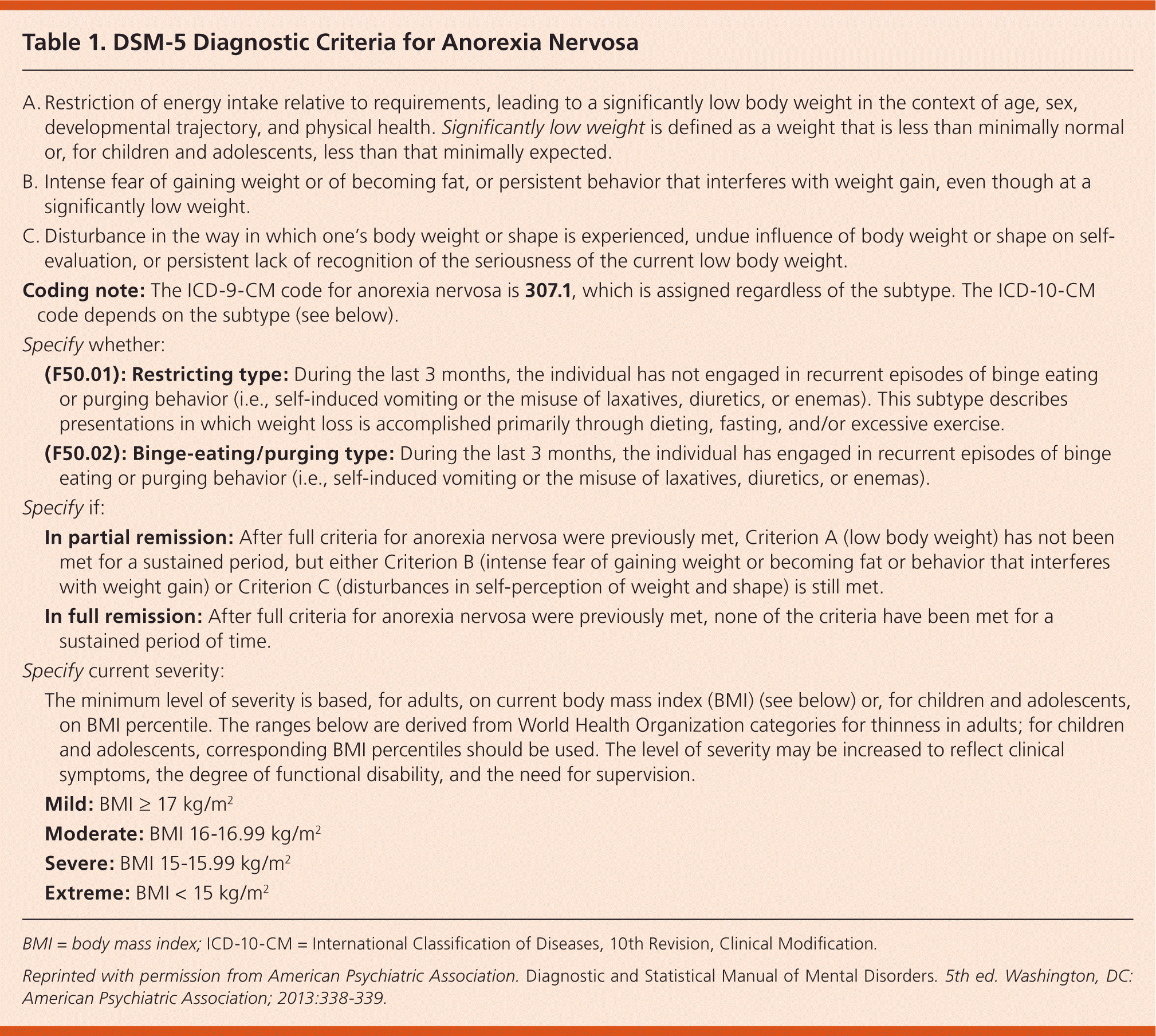
| A. Restriction of energy intake relative to requirements, leading to a significantly low body weight in the context of age, sex, developmental trajectory, and physical health. Significantly low weight is defined as a weight that is less than minimally normal or, for children and adolescents, less than that minimally expected. | |
| B. Intense fear of gaining weight or of becoming fat, or persistent behavior that interferes with weight gain, even though at a significantly low weight. | |
| C. Disturbance in the way in which one's body weight or shape is experienced, undue influence of body weight or shape on self-evaluation, or persistent lack of recognition of the seriousness of the current low body weight. | |
| Coding note: The ICD-9-CM code for anorexia nervosa is 307.1, which is assigned regardless of the subtype. The ICD-10-CM code depends on the subtype (see below). | |
| Specify whether: | |
| (F50.01): Restricting type: During the last 3 months, the individual has not engaged in recurrent episodes of binge eating or purging behavior (i.e., self-induced vomiting or the misuse of laxatives, diuretics, or enemas). This subtype describes presentations in which weight loss is accomplished primarily through dieting, fasting, and/or excessive exercise. | |
| (F50.02): Binge-eating/purging type: During the last 3 months, the individual has engaged in recurrent episodes of binge eating or purging behavior (i.e., self-induced vomiting or the misuse of laxatives, diuretics, or enemas). | |
| Specify if: | |
| In partial remission: After full criteria for anorexia nervosa were previously met, Criterion A (low body weight) has not been met for a sustained period, but either Criterion B (intense fear of gaining weight or becoming fat or behavior that interferes with weight gain) or Criterion C (disturbances in self-perception of weight and shape) is still met. | |
| In full remission: After full criteria for anorexia nervosa were previously met, none of the criteria have been met for a sustained period of time. | |
| Specify current severity: | |
| The minimum level of severity is based, for adults, on current body mass index (BMI) (see below) or, for children and adolescents, on BMI percentile. The ranges below are derived from World Health Organization categories for thinness in adults; for children and adolescents, corresponding BMI percentiles should be used. The level of severity may be increased to reflect clinical symptoms, the degree of functional disability, and the need for supervision. | |
| Mild: BMI ≥ 17 kg/m2 | |
| Moderate: BMI 16–16.99 kg/m2 | |
| Severe: BMI 15–15.99 kg/m2 | |
| Extreme: BMI < 15 kg/m2 | |
Bulimia nervosa involves the uncontrolled eating of an abnormally large amount of food in a short period, followed by compensatory behaviors, such as self-induced vomiting, laxative abuse, or excessive exercise. The main update in the DSM-5 criteria for bulimia nervosa (Table 23 ) is a decrease in the average frequency of bingeing and purging from twice to once a week.4
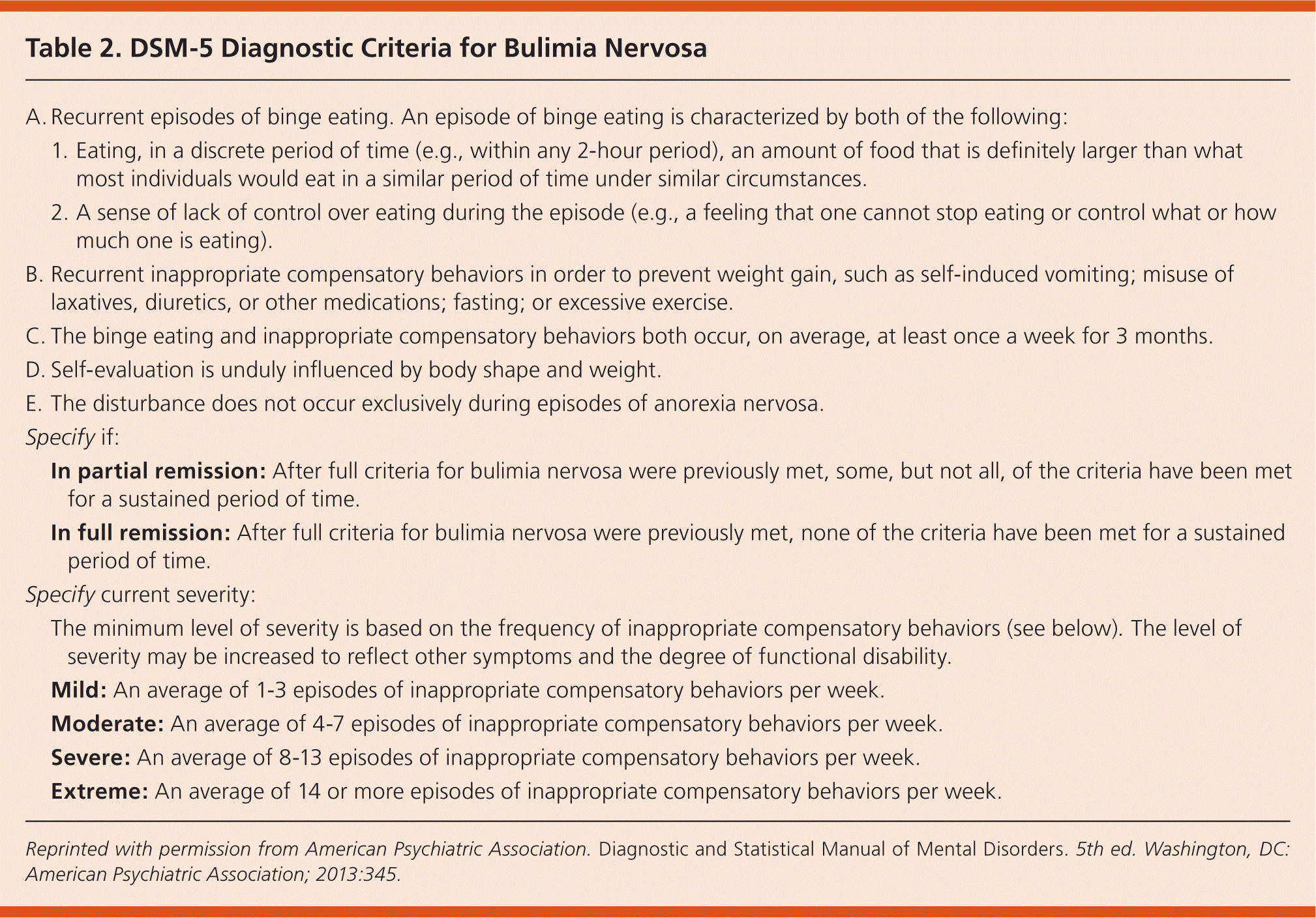
| A. Recurrent episodes of binge eating. An episode of binge eating is characterized by both of the following: | |
| 1. Eating, in a discrete period of time (e.g., within any 2-hour period), an amount of food that is definitely larger than what most individuals would eat in a similar period of time under similar circumstances. | |
| 2. A sense of lack of control over eating during the episode (e.g., a feeling that one cannot stop eating or control what or howmuch one is eating). | |
| B. Recurrent inappropriate compensatory behaviors in order to prevent weight gain, such as self-induced vomiting; misuse oflaxatives, diuretics, or other medications; fasting; or excessive exercise. | |
| C. The binge eating and inappropriate compensatory behaviors both occur, on average, at least once a week for 3 months. | |
| D. Self-evaluation is unduly influenced by body shape and weight. | |
| E. The disturbance does not occur exclusively during episodes of anorexia nervosa. | |
| Specify if: | |
| In partial remission: After full criteria for bulimia nervosa were previously met, some, but not all, of the criteria have been met for a sustained period of time. | |
| In full remission: After full criteria for bulimia nervosa were previously met, none of the criteria have been met for a sustained period of time. | |
| Specify current severity: | |
| The minimum level of severity is based on the frequency of inappropriate compensatory behaviors (see below). The level of severity may be increased to reflect other symptoms and the degree of functional disability. | |
| Mild: An average of 1–3 episodes of inappropriate compensatory behaviors per week. | |
| Moderate: An average of 4–7 episodes of inappropriate compensatory behaviors per week. | |
| Severe: An average of 8–13 episodes of inappropriate compensatory behaviors per week. | |
| Extreme: An average of 14 or more episodes of inappropriate compensatory behaviors per week. | |
Prevalence and Etiology
Bulimia nervosa affects four to six out of 200 females in the United States. Anorexia nervosa is much less common, with a lifetime prevalence of one out of 200 females in the United States. Approximately 95% of persons with an eating disorder are 12 to 25 years of age. Although 90% of patients with an eating disorder are female, the incidence of diagnosed eating disorders in males appears to be increasing.5
The etiology of eating disorders is unknown and probably multifactorial. Environmental influences include societal idealizations about weight and body shape. Parenting style has been discounted as a primary cause of eating disorders. However, parenting style, household stress, and parental discord may contribute to anxiety and personality traits that are risk factors for an eating disorder. An emphasis on success and external rewards may lead to overly high expectations. Children may then try to be successful with something they can control: regulating what they eat and how they look. Sexual assault or abuse has not been associated with anorexia nervosa but may be a risk factor for bulimia nervosa.6
There is increasing evidence of biologic risk factors for eating disorders. Twin studies and other research suggest a genetic link.7 Eating disorders have been associated with abnormal neurotransmitter systems involving serotonin and dopamine.8,9 The role of hormones such as ghrelin, leptin, and oxytocin has also been investigated.10
Clinical Presentation
Table 3 includes clinical signs of eating disorders.11–13 Patients with eating disorders may often comment about being “fat” or not liking their body shape. Weight loss with anorexia nervosa may go unnoticed for some time, particularly when patients wear baggy clothes or extra layers. Patients with anorexia nervosa commonly restrict their diet to vegetables, fruit, and diet products, and often skip meals altogether. They develop mealtime rituals, such as cutting food into tiny pieces, patting liquid off with napkins, or picking food apart. Although anorexia nervosa has been associated with some cognitive deficits as demonstrated on neuropsychological tests, many patients maintain good cognitive function and verbal fluency even when malnourished.14
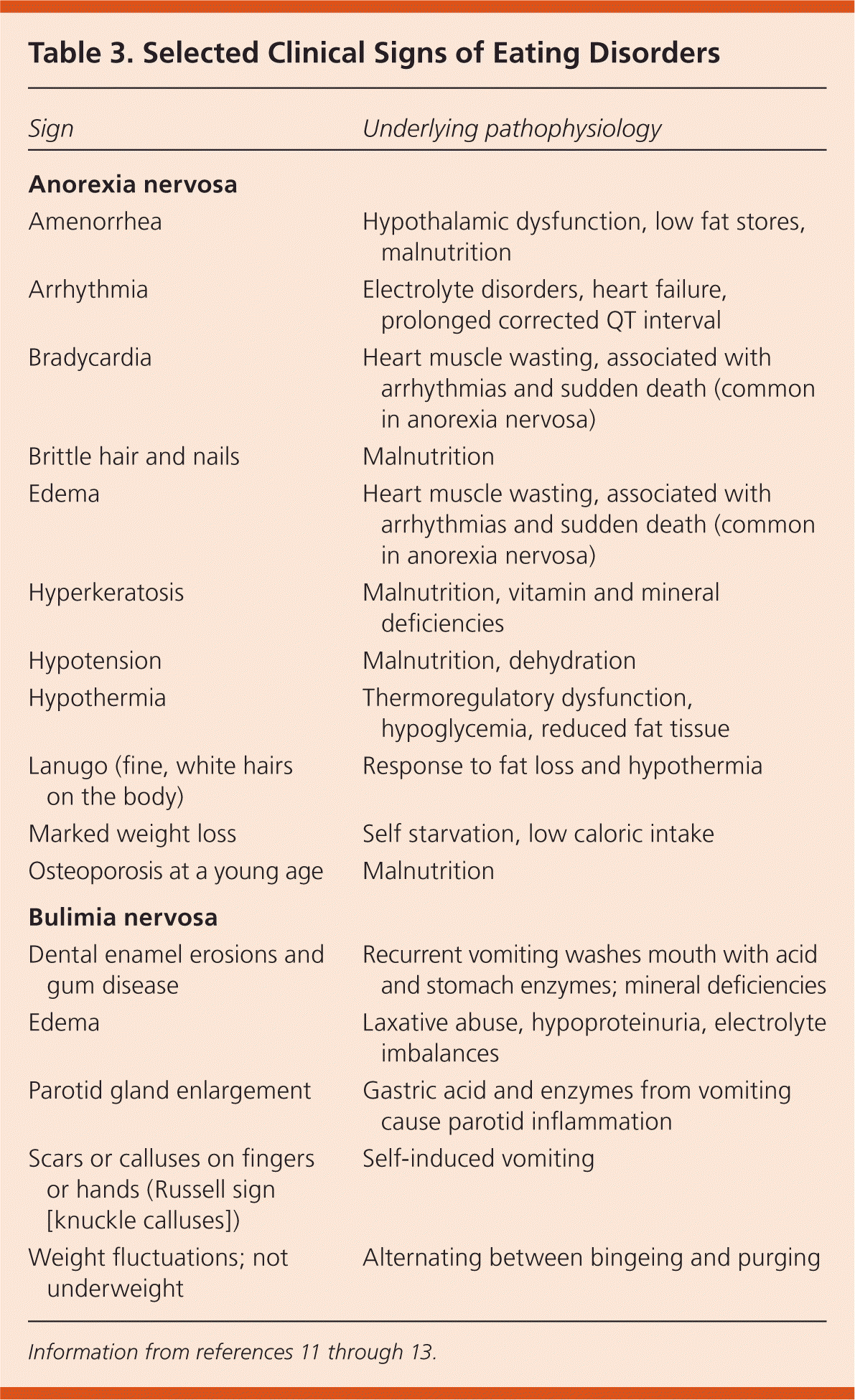
| Sign | Underlying pathophysiology |
|---|---|
| Anorexia nervosa | |
| Amenorrhea | Hypothalamic dysfunction, low fat stores, malnutrition |
| Arrhythmia | Electrolyte disorders, heart failure, prolonged corrected QT interval |
| Bradycardia | Heart muscle wasting, associated with arrhythmias and sudden death (common in anorexia nervosa) |
| Brittle hair and nails | Malnutrition |
| Edema | Heart muscle wasting, associated with arrhythmias and sudden death (common in anorexia nervosa) |
| Hyperkeratosis | Malnutrition, vitamin and mineral deficiencies |
| Hypotension | Malnutrition, dehydration |
| Hypothermia | Thermoregulatory dysfunction, hypoglycemia, reduced fat tissue |
| Lanugo (fine, white hairs on the body) | Response to fat loss and hypothermia |
| Marked weight loss | Self starvation, low caloric intake |
| Osteoporosis at a young age | Malnutrition |
| Bulimia nervosa | |
| Dental enamel erosions and gum disease | Recurrent vomiting washes mouth with acid and stomach enzymes; mineral deficiencies |
| Edema | Laxative abuse, hypoproteinuria, electrolyte imbalances |
| Parotid gland enlargement | Gastric acid and enzymes from vomiting cause parotid inflammation |
| Scars or calluses on fingers or hands (Russell sign [knuckle calluses]) | Self-induced vomiting |
| Weight fluctuations; not underweight | Alternating between bingeing and purging |
Patients with eating disorders often engage in excessive physical activity despite bad weather, illness, or injury. A study found that approximately one-third of patients hospitalized for anorexia nervosa reported excessive (i.e., obligatory, obsessive, or driven) exercise during the three months before admission.15
Patients with bulimia nervosa may arrange complex schedules to accommodate episodes of binge eating and purging, often accompanied by frequent trips to the bathroom. In addition to excessive exercise, other methods of weight control include abuse of laxatives or diuretics. Frequent self-induced vomiting can contribute to parotitis, stained teeth or enamel erosions, and hand calluses.
As cachexia progresses, patients with anorexia nervosa lose strength and endurance, move more slowly, and demonstrate decreased performance in sports. Overuse injuries and stress fractures can occur. Bradycardia, orthostatic hypotension, and palpitations may progress to potentially fatal arrhythmias. Epigastric pain and a bloating sensation are common. Laxative abuse causes hemorrhoids and rectal prolapse. Severe hypoglycemia may lead to seizures. Wounds heal poorly. Endocrine symptoms in anorexia nervosa include hypothermia (feeling cold), delayed onset of menses or secondary amenorrhea, and osteopenia progressing to osteoporosis.11,12
More than one-half of patients with eating disorders meet criteria for a current or past episode of major depression.16 Anorexia nervosa is associated with an increased risk of suicide, with the suicide standardized mortality ratio estimated to be as high as 31 in one meta-analysis.17 Other associated psychiatric disorders include obsessive-compulsive disorder, obsessive-compulsive personality disorder, social phobia, anxiety disorders, substance use disorders, and personality disorders. Psychological symptoms include heightened emotional arousal, reduced tolerance of stress, emotional dysregulation, social withdrawal, and self-critical perfectionistic traits.3
Screening for Eating Disorders
Annual health supervision examinations and preparticipation sports physicals are ideal screening opportunities. In addition to weight, height, and body mass index measurements, a screening tool such as the SCOFF questionnaire (Table 418 ) can be used.11,12,18 The SCOFF questionnaire has been validated only in adults but suggests an approach that can also be used with children.12
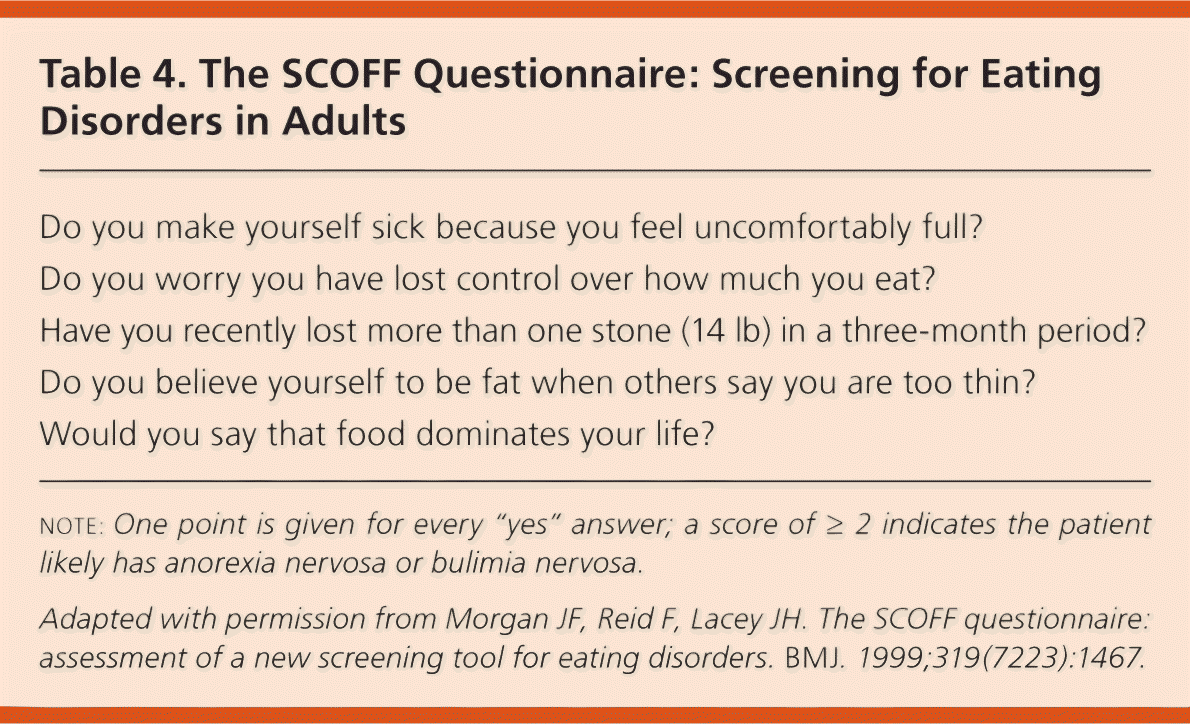
| Do you make yourself sick because you feel uncomfortably full? |
| Do you worry you have lost control over how much you eat? |
| Have you recently lost more than one stone (14 lb) in a three-month period? |
| Do you believe yourself to be fat when others say you are too thin? |
| Would you say that food dominates your life? |
Initial Evaluation
The first priority in the evaluation of patients with eating disorders is to identify emergency medical conditions that require hospitalization and stabilization. Before the patient is weighed, a urine sample should be obtained to assess specific gravity for hydration status, pH level, ketone level, and signs of kidney damage. Weight, height, body mass index, and body temperature should be recorded. Because patients may wear extra clothes or hide heavy items to exaggerate their weight, they should be weighed wearing only underwear and a hospital gown. An attendant or parent may have to be present while they change. Clinicians may consider having patients face away from the scale so that they do not know their weight. Blood pressure should be recorded with orthostatic vital signs.
Electrocardiography and laboratory studies such as urinalysis with specific gravity, complete blood count, complete metabolic panel, amylase and lipase measurement, phosphorous and magnesium measurement, and thyroid function tests (thyroid-stimulating hormone, thyroxine, free triiodothyronine) should be performed promptly.11,12 Less urgent testing, such as bone density testing, can be deferred.
Treatment
Family physicians can fill a central role in the monitoring and treatment of patients with eating disorders. A psychotherapist or psychiatrist usually is involved. Eating disorder specialists, often with backgrounds in psychiatry or adolescent medicine, are ideally involved but may not be available in some locations. A dietitian can help select nutritious and calorie-rich foods. For youth, it is critical to involve their schools. Most states require formal 504 plans that spell out special accommodations, such as snack breaks in class or allowances for missed school, to allow equal educational opportunities for students with medical disabilities.
Treatment success may be dependent on developing a therapeutic alliance with the patient, involvement of the patient's family, and close collaboration within the treatment team. Additional online resources for the treatment team, patient, and family are listed in eTable A.
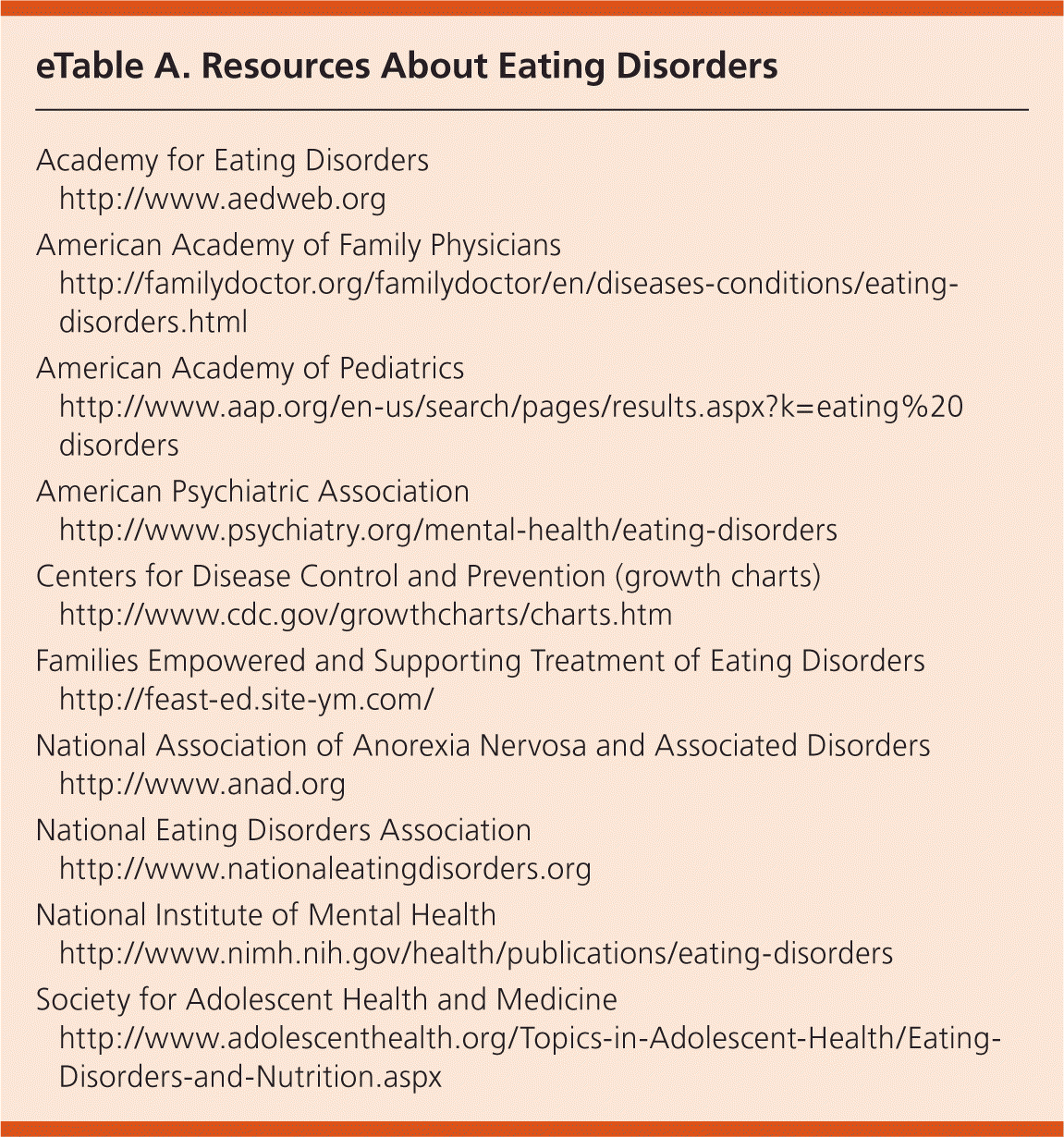
| Academy for Eating Disorders | |
| http://www.aedweb.org | |
| American Academy of Family Physicians | |
| https://familydoctor.org/familydoctor/en/diseases-conditions/eating-disorders.html | |
| American Academy of Pediatrics | |
| http://www.aap.org/en-us/search/pages/results.aspx?k=eating%20disorders | |
| American Psychiatric Association | |
| http://www.psychiatry.org/mental-health/eating-disorders | |
| Centers for Disease Control and Prevention (growth charts) | |
| http://www.cdc.gov/growthcharts/charts.htm | |
| Families Empowered and Supporting Treatment of Eating Disorders | |
| http://feast-ed.site-ym.com/ | |
| National Association of Anorexia Nervosa and Associated Disorders | |
| http://www.anad.org | |
| National Eating Disorders Association | |
| http://www.nationaleatingdisorders.org | |
| National Institute of Mental Health | |
| http://www.nimh.nih.gov/health/topics/eating-disorders/index.shtml | |
| Society for Adolescent Health and Medicine | |
| http://www.adolescenthealth.org/Topics-in-Adolescent-Health/Eating-Disorders-and-Nutrition.aspx | |
INPATIENT
Treatment should be individualized based on symptom severity, course of illness, psychiatric comorbidity, availability of psychosocial/familial support, patient motivation for undergoing treatment, regional availability of specialized treatment programs, and medical stability. Indications for hospitalization include significant electrolyte abnormalities, arrhythmias or severe bradycardia, rapid persistent weight loss in spite of outpatient therapy, and serious comorbid medical or psychiatric conditions, including suicidal ideation.11,12 Table 5 includes the American Academy of Pediatrics criteria for inpatient treatment.19 After the patient is stabilized at a local hospital, his or her condition or comorbidities may necessitate transfer to a facility specializing in eating disorder inpatient care.
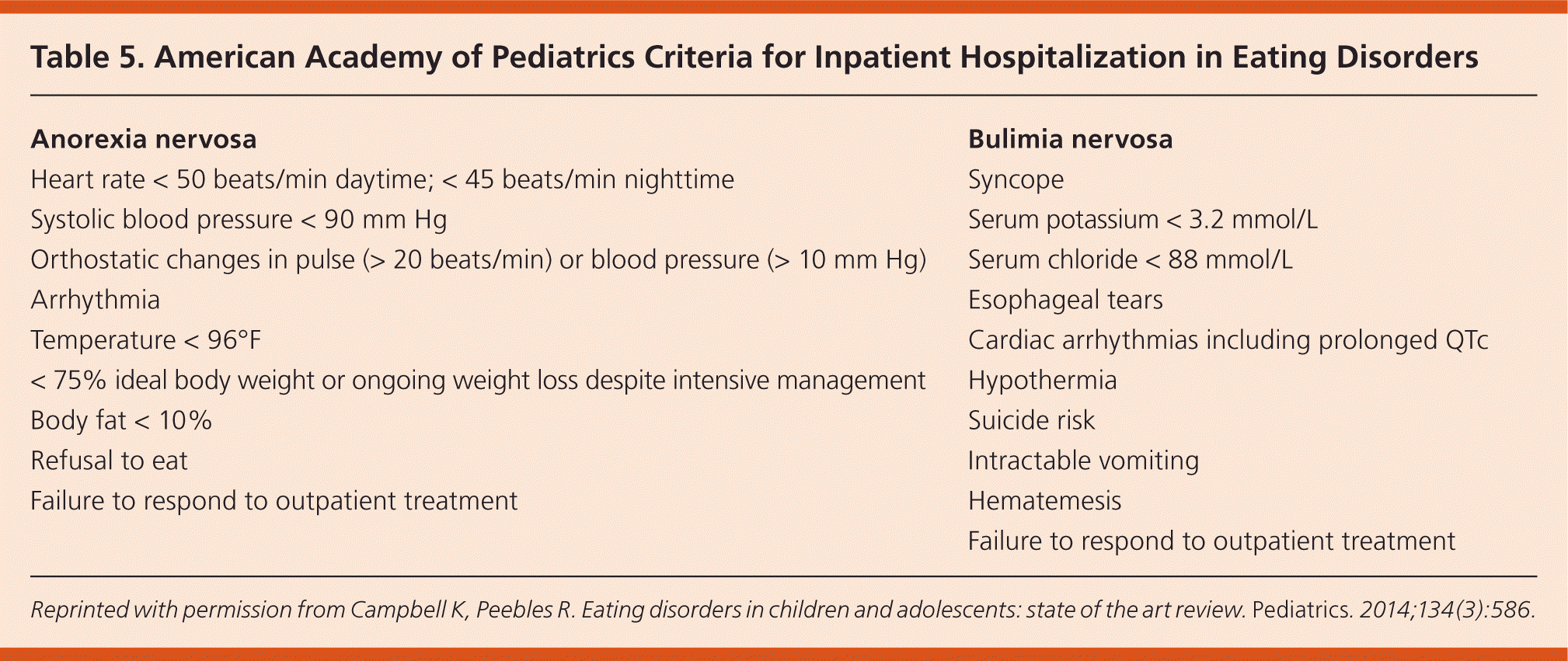
| Anorexia nervosa |
| Heart rate < 50 beats/min daytime; < 45 beats/min nighttime |
| Systolic blood pressure < 90 mm Hg |
| Orthostatic changes in pulse (> 20 beats/min) or blood pressure (> 10 mm Hg) |
| Arrhythmia |
| Temperature < 96°F |
| < 75% ideal body weight or ongoing weight loss despite intensive management |
| Body fat < 10% |
| Refusal to eat |
| Failure to respond to outpatient treatment |
| Bulimia nervosa |
| Syncope |
| Serum potassium < 3.2 mmol/L |
| Serum chloride < 88 mmol/L |
| Esophageal tears |
| Cardiac arrhythmias including prolonged QTc |
| Hypothermia |
| Suicide risk |
| Intractable vomiting |
| Hematemesis |
| Failure to respond to outpatient treatment |
The focus of initial treatment for patients who have anorexia nervosa with cachexia is restoring nutritional health, with weight gain as a surrogate marker. Feeding tubes may be needed in severe cases when the patient has a high resistance to eating. Refeeding syndrome can occur in a malnourished individual when a rapid increase in food intake results in dramatic fluid and electrolyte shifts, and is potentially fatal. Thus, hospitalization should be considered for initial treatment of any seriously malnourished patient to allow for daily monitoring of key markers such as weight, heart rate, temperature, hydration, and serum phosphorus level.20
OUTPATIENT
Nutritional Intervention and Weight Restoration. Patients with anorexia may eat only 500 kcal a day, whereas the average daily caloric requirement for a sedentary adolescent is 1,800 kcal for females and 2,200 kcal for males.21 A reasonable initial target for weight restoration is 90% of the average weight expected for the patient's age, height, and sex.12,22 Growth charts are available from the Centers for Disease Control and Prevention at http://www.cdc.gov/growthcharts/charts.htm. Initiation or resumption of menses is an important marker of biologic health in females. In one report, 86% of females with anorexia nervosa who achieved the 90% body mass index goal resumed menses within six months.22 The patient's pre–eating disorder weight history may help in determining a target body mass index. For growing adolescents, the goal weight may need to be adjusted every three to six months. Weight gain may not begin until caloric intake significantly exceeds sedentary requirements. Strenuous physical activity and sports should be restricted.
Nutritional guidance focuses on healthy food intake and regaining the energy needed to resume activities. Although calorie counting is important, it generally should not be discussed with the patient. Daily menus should include three full meals and a structured snack schedule that is monitored by parents or the school nurse. A multivitamin plus vitamin D and calcium supplements are recommended.
Psychotherapy. Psychotherapy is the foundation for successful treatment of an eating disorder. Family-based treatment (the Maudsley method) is one of the more promising approaches for adolescents with anorexia nervosa.23–25 Goals of psychotherapy include reduction of distorted body image and dysfunctional eating habits, return to social engagement, and resumption of full physical activities.26 Family members need support and help learning how to care for the patient. Clinical trials have shown significant improvement in bulimia nervosa with cognitive behavior therapy and interpersonal psychotherapy.27 Group therapy is used in many eating disorder treatment programs. Alternate adjunctive therapies such as equine therapy (based on the idea that caring for horses through grooming and other interactions is healing) may hold promise, although they are not evidence-based therapies.28 Mindfulness practices such as meditation and yoga benefit patients with anxiety and may provide low-energy physical activity.29
Medications. Studies have shown only limited benefit of medications in the treatment of anorexia nervosa. Antidepressants, including selective serotonin reuptake inhibitors (SSRIs), may help mitigate symptoms of depression and suicidal ideation in patients with anorexia nervosa. However, they have not proved beneficial in facilitating weight restoration or preventing relapse.30,31 Although case reports and recent preliminary studies have suggested a role for atypical antipsychotics such as olanzapine (Zyprexa), controlled studies have not demonstrated significant benefit in patients with anorexia nervosa.11,32–35 Larger placebo-controlled studies will be needed to evaluate this approach. If psychotropic medications are attempted, the patient should be closely monitored, possibly in an inpatient or residential setting, and supervised by a psychiatrist or eating disorder specialist.
In patients with bulimia nervosa, studies have suggested SSRIs may be beneficial in decreasing the frequency of binge eating and purging.35–37 Thus, the addition of an SSRI might be considered for patients who are not responding to an initial trial of psychotherapy and for patients with major depression or another comorbid disorder responsive to antidepressant medications.
Prognosis
Although approximately one-half of patients with anorexia nervosa fully recover, about 30% achieve only partial recovery, and 20% remain chronically ill.38 Anorexia nervosa has the highest mortality rate of any mental health disorder, with an estimated all-cause standardized mortality ratio of 1.7 to 5.9.39,40 The prognosis for bulimia nervosa is more favorable, with up to 80% of patients achieving remission with treatment. However, the 20% relapse rate represents a significant clinical challenge, and the disorder is associated with an elevated all-cause standardized mortality ratio of 1.6 to 1.9.39,40
Data Sources: Literature searches on Ovid Medline were performed. Key terms were anorexia nervosa, bulimia nervosa, eating disorder, etiology, diagnosis, signs and symptoms, and treatment. The search included meta-analyses, randomized controlled trials, clinical trials, and review articles. The search was limited to human, English, and full text. Subsequent Ovid Medline searches were conducted looking for specific topics such as zinc and eating disorders. Additional searches included the archives for the journals Pediatrics and American Family Physician, Agency for Healthcare Research and Quality evidence reports, the Cochrane database, the National Guideline Clearinghouse database, the U.S. Preventive Services Task Force, the American Academy of Pediatrics, the American Psychiatric Association, and the Society for Adolescent Health and Medicine. Search dates: November 18, 2013; December 1, 2013; July 14, 2014; and October 22, 2014.
